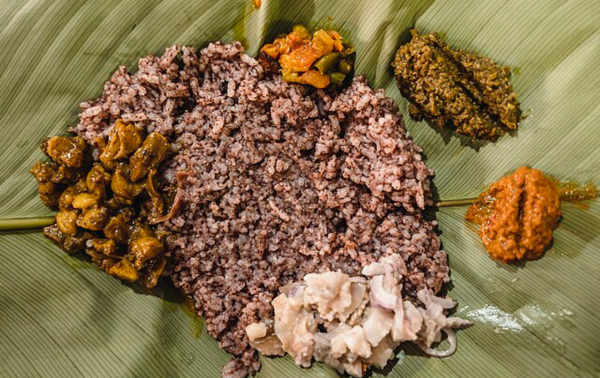Rooted in the lush hills of Meghalaya, Khasi cuisine embodies a harmonious blend of locally sourced distinct ingredients due to the natural environment, traditional cooking methods, and age-old recipes passed down through generations.
From sticky rice to fermented dry fish chutney, each dish tells a story of resilience, cyclic consumption, and culinary artistry. Unlike its more elaborately spiced neighbors, Khasi cuisine boasts a refreshing simplicity. Limited access to a wider array of spices in the past led to a focus on fresh, local ingredients and ancient preservation methods like smoking and fermentation. Pork, a staple protein source for the Khasis due to their history of animal husbandry, features prominently in their dishes. Khasi cuisine is intricately intertwined with the local landscape, where ingredients are sourced from the mountains, forests, fields, and rivers that surround the community. Traditional cooking styles, such as slow cooking meats above the oven for months to achieve the perfect smoked flavor, and using gourd shells to cook rice, showcase the resourcefulness and ingenuity of the people. The practice of jhum cultivation, where patches of forests are cleared for cultivation and left fallow to regenerate, reflects a sustainable approach to agriculture that has sustained the community for generations.

From the indigenous variety of red rice known as Khawkhasi to the use of powdered cattle bone for fertilizing the soil, every aspect of Khasi cuisine reflects a deep-rooted connection to the land and a commitment to sustainable living. No exploration of Khasi cuisine is complete without encountering Jadoh, the undisputed king of the table. This comforting dish of rice cooked with generous portions of pork, aromatic onions, and a hint of turmeric is a staple in every Khasi household. Traditionally, red rice, cultivated on the slopes of Meghalaya, lends Jadoh its vibrant color and earthy flavor. Variations include the inclusion of chicken or fish, but the essence remains the same – a hearty dish that fuels the lives of the Khasi people. Khasi cuisine extends far beyond Jadoh. Doh Khleh is a delicious salad of boiled and chopped pork brain seasoned with local herbs. For vegetarians, there’s a bounty of options like Tungrymbai, fermented soybeans cooked with black sesame seeds, offering a unique combination of textures and a nutty flavour. Rice cakes called “Pu” come in various forms – steamed, fried, or wrapped in banana leaves – offering a delightful textural contrast to the stews and curries.
Throughout history, Khasi cuisine has been a cornerstone of cultural identity, preserving age-old recipes and culinary traditions that define the community’s way of life, weaving itself into the fabric of everyday life and special occasions. Festivals like Nongkrem, a harvest festival, are marked by elaborate feasts featuring delicacies like smoked meats and seasonal vegetables. These shared meals serve as a powerful tool for transmitting cultural knowledge and traditions from one generation to the next. In an era of fast food and homogenization, the future of Khasi cuisine faces challenges. Urbanization and migration threaten the traditional knowledge base associated with food production and preparation.

The Khasi people’s deep connection to the land, their commitment to traditional practices, and their reverence for local ingredients serve as a blueprint for fostering a more sustainable and culturally rich future. By learning from the Khasi community and their culinary traditions, we can gain insights into the importance of preserving heritage, nurturing the environment, and celebrating the cultural confluence that defines our identities. Khasi cuisine is not just a feast for the senses; it is a celebration of tradition, indigenous knowledge systems, and cultural heritage. However, the future of Khasi cuisine hinges on a collaborative effort. Promoting homegrown ingredients and traditional cooking methods is crucial. Documentation of recipes and food stories can ensure the knowledge is not lost. Most importantly, encouraging families to continue sharing meals strengthens the cultural fabric and ensures that the smoky symphony of Khasi cuisine continues to resonate for years to come.
By – Sulagna Maitra
Sources:
https://vikalpsangam.org/article/the-food-culture-of-khasi-hills/
https://ijcrt.org/papers/IJCRT2203472.pdf
https://www.zizira.com/blogs/people-and-process/lore-history-traditional-meghalaya-food
https://www.meghalayatourism.in/experiences-4/indigenous-cuisines/
